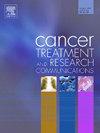增强T细胞浸润在胶质母细胞瘤中的作用:挑战和治疗策略综述。
IF 2.4
Q3 Medicine
引用次数: 0
摘要
本文就增强t细胞在胶质母细胞瘤(GBM)中的浸润并克服其免疫抑制肿瘤微环境(TME)作一综述。关键策略包括靶向髓源性抑制细胞(MDSCs)以减少免疫抑制和肿瘤相关巨噬细胞(tam)从M2(免疫抑制)表型到M1(促炎)表型的再极化,以增加t细胞功能。施用趋化因子可以帮助吸引更多的效应T细胞到肿瘤部位。免疫检查点抑制剂(ICIs)与其他治疗方法联合使用可进一步提高T细胞活性。为了使免疫治疗在GBM中更有效,还必须解决TME中的免疫抑制信号,如转化生长因子β (TGF-β)和白细胞介素-10 (IL-10)。本文章由计算机程序翻译,如有差异,请以英文原文为准。
Enhancing T cell infiltration in glioblastoma: a review article on challenges and therapeutic strategies
This review focuses on enhancing T-cell infiltration in glioblastoma (GBM) while overcoming its immunosuppressive tumor microenvironment (TME). Key strategies include targeting myeloid-derived suppressor cells (MDSCs) to reduce immunosuppression and repolarizing tumor-associated macrophages (TAMs) from an M2 (immunosuppressive) phenotype to an M1 (proinflammatory) phenotype to increase T-cell function. Administering chemokines can help attract more effector T cells to the tumor site. Combining immune checkpoint inhibitors (ICIs) with other treatments can further increase T cell activity. To make immunotherapy more effective in GBM, it is also essential to address the immunosuppressive signals in the TME, such as transforming growth factor beta (TGF-β) and interleukin-10 (IL-10).
求助全文
通过发布文献求助,成功后即可免费获取论文全文。
去求助
来源期刊

Cancer treatment and research communications
Medicine-Oncology
CiteScore
4.30
自引率
0.00%
发文量
148
审稿时长
56 days
期刊介绍:
Cancer Treatment and Research Communications is an international peer-reviewed publication dedicated to providing comprehensive basic, translational, and clinical oncology research. The journal is devoted to articles on detection, diagnosis, prevention, policy, and treatment of cancer and provides a global forum for the nurturing and development of future generations of oncology scientists. Cancer Treatment and Research Communications publishes comprehensive reviews and original studies describing various aspects of basic through clinical research of all tumor types. The journal also accepts clinical studies in oncology, with an emphasis on prospective early phase clinical trials. Specific areas of interest include basic, translational, and clinical research and mechanistic approaches; cancer biology; molecular carcinogenesis; genetics and genomics; stem cell and developmental biology; immunology; molecular and cellular oncology; systems biology; drug sensitivity and resistance; gene and antisense therapy; pathology, markers, and prognostic indicators; chemoprevention strategies; multimodality therapy; cancer policy; and integration of various approaches. Our mission is to be the premier source of relevant information through promoting excellence in research and facilitating the timely translation of that science to health care and clinical practice.
 求助内容:
求助内容: 应助结果提醒方式:
应助结果提醒方式:


